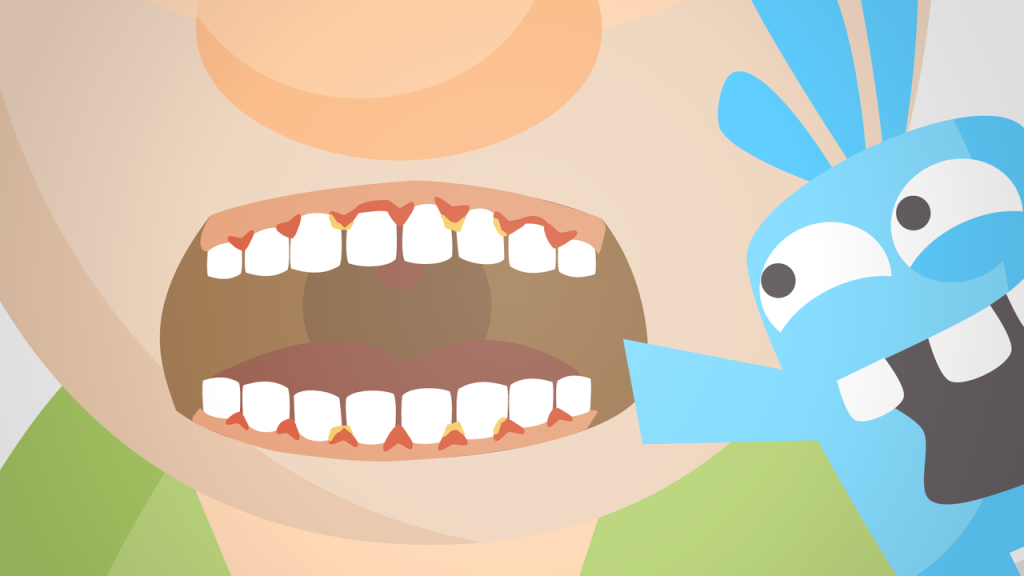I know – diabetes and oral health don’t seem related – but having diabetes means we’re twice as likely to develop gum disease, which means it's important for us to know this stuff.
What is gum disease?
Otherwise known as periodontal disease, gum disease is the infection of structures around the tooth, eventually leading to tooth loss if left untreated. Without routine dental inspection, it often goes unnoticed for too long and is actually the leading cause of adult tooth loss!
Whoa... how does it happen?
It’s all about bacteria.
Did you know you have millions of bacteria in your mouth? More bacteria than the number of people on earth, even! But don’t worry. That’s normal.
Most of that bacteria is harmless, but some of it attacks the teeth and gums. That harmful bacteria live in the plaque that builds up on teeth between brushing.
We cope with plaque (and therefore, the bad bacteria) by following our dentist’s instructions (brush twice daily, floss regularly, visit the dentist for deep cleanings twice a year). This is more important than I realized!
I didn’t know until researching for this article that plaque can build up and harden into tartar in as little as 24 hours. Tartar is nasty, stubborn stuff, and only a visit to your dentist for a good, deep cleaning can remove it.
Dentists are also able to clean plaque and tartar from places we can’t reach with a toothbrush or floss. This is important, because once the bacteria find refuge below the gumline, it’s protected from our attempts to get rid of it and starts causing trouble.
Angry gums
The first stage of this bacterial attack is gingivitis; red, swollen gums that may bleed when brushing your teeth. One article mentioned how strange it would be if our hands bled when we washed them, yet many people think it’s normal for gums to bleed when brushing.
Far from normal, actually! It is a clue that our chompers need attention. Swollen and bleeding gums are early signs of infection!
Receding gums and pockets?
Left untreated, infection causes the inner layer of gums and bone to recede, forming small spaces between the teeth and gums. These pockets collect debris and become even more infected. It’s a nasty situation. Debris, plaque and tartar – an ideal environment for infection.
The body reacts to fight the infection, but the defensive enzymes along with the bacterial toxins actually break down the bone and connective tissues even more. The pockets deepen and more damage occurs. The infection runs rampant and is hard to gain control of.
And more diabetes stuff?
And what do we know about infections and blood sugar? We know two things:
- Any infection can make blood sugars harder to manage, and
- high blood sugars can make infections harder to manage
What a vicious cycle! That's why it's so important to stay ahead of it!
Dry mouth?
Do you ever get thirsty when your blood sugar is high? Has your mouth been so dry it feels like you’re sucking on a sponge? Did you know your spit actually helps protect your teeth from cavities? Me either! Having a dry mouth isn’t just uncomfortable, it’s bad for your teeth!
What can I do?
It’s not all bad news and scary information. There are a few simple things (and one not-so-simple thing) that you can do to help keep your teeth powerful and pretty.
The surprising part? You already know everything I’m about to tell you.
- Visit a dentist at least twice each year for a professional cleaning and oral exam
- follow any additional instructions or recommendations they give
- Brush your teeth at least twice each day
- especially first thing in the morning and right before bed
- use fluoride toothpaste
- brush for at least two minutes
- Floss every day
The not-so-simple thing? Managing blood sugar.
I’m not going to preach about reducing risks and keeping blood sugars as close to targets as possible. We both know all of that already. And we both already know it’s easy to say and hard to do.
What you may not know is that every little bit helps, especially if you’re on the high end. So be safe, avoid lows, and don’t forget to brush! Remember – taking care of your teeth is a big piece of the diabetes management puzzle.
The mySugr website does not provide medical or legal advice. mySugr blog articles are not scientific articles, but intended for informational purposes only.
Medical or nutritional information on the mySugr website is not intended to replace professional medical advice, diagnosis or treatment. Always consult a physician or health care provider with any questions you may have regarding a medical condition.


